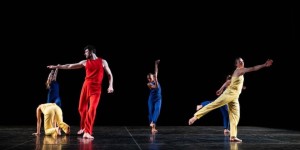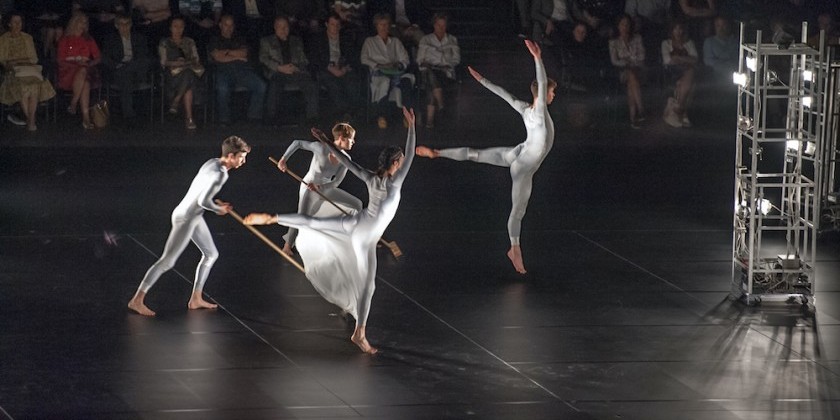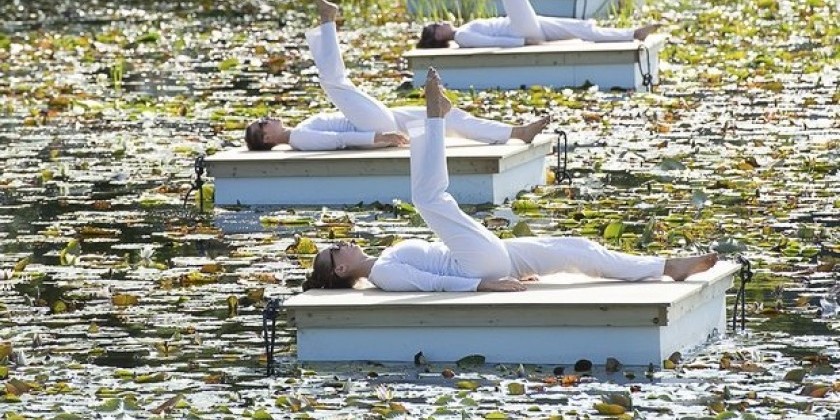DAY IN THE LIFE OF DANCE: Trisha Brown Dance Company Prepares for Season at The Joyce Theater

Classics by Trisha Brown and a Commissioned World Premiere "Time Again" by Lee Serle, Running from April 29-May 4, 2025
World premiere commission: “Time again” by Lee Serle in collaboration with Colombian visual artist Mateo López, set to an original score by Alisdair Macindoe
Works by Trisha Brown: “Son of Gone Fishin’” (1981) and “Opal Loop/Cloud Installation #72503” (1980)
Dancers: Savannah Gaillard, Rochelle Jamila, Burr Johnson, Ashley Merker, Patrick Needham, Jennifer Payán, and Spencer James Weidie
Tickets & More Info
The third floor studio at The Joyce Theater’s New York Center for Creativity and Dance is a lovably strange space to experience dance. Its drop ceiling and buzzy fluorescent lights seem to graze heads; soaring jumps and high lifts are impossible here. The overzealous radiators pump out steamy heat; the window air conditioning unit rattles back in futile combat. The atmosphere is sauna-like, almost oppressive as weak gray light struggles through the frosted glass windows. The studio feels quite small, so it surprises me to learn that its dimensions correspond almost exactly to the Joyce stage. Still, the close walls and low ceiling lend a sense of containment — this is not yet a proscenium-framed performance, but rather an intimate laboratory for focused creative experimentation, a hive abuzz with movement, sound, and sweat.

Today I am fortunate to share this space with the artists of the Trisha Brown Dance Company (TBDC), many of whom are familiar to me from classes and workshops with the Merce Cunningham Trust. Having danced alongside these particular artists in technical exercises and choreographies, I’ve noted their supreme composure and relaxed precision: they are strong but never tense, direct but never stiff, open and unaffected in their self-presentation. Watching them in rehearsal and on stage in the works of Brown and others, these qualities translate into quiet astonishment: their unflagging athleticism and deceptively simple virtuosities invite a studied, kinesthetically empathetic viewership.

On this cold, wet Friday afternoon, the dancers trickle in from their lunch break to process and revive their movement patterns and sequences at low volume. They’re picking up the creation process for Lee Serle’s commissioned work, “Time again,” which will premiere alongside Brown’s work in a matter of days. They move around three multi-paneled sculptures, newly-arrived contributions by Serle’s collaborator, Colombian artist Mateo López; the tight weave and rough texture of their agave fibers lend a presence both architectural and organic. The sculptures create opportunities to play with modularity and visibility—also themes in Brown’s work. With his approach to this design collaboration, Serle says, “I love to give audiences a slightly different perspective and point of view, rather than everyone having the same experience.”

These experiences begin to emerge as choreographer and dancers experiment with ways to move and configure the flat panels and arched doorways of López’s sculpture into an octagonal, open-roofed bohío, or hut: unfold, tilt down, drag, tilt up, refold, repeat. They are patient — these are unfamiliar dance partners — and soon they shift into arranging sections of choreography around the sculptures. Dancing materializes from walking, unspools into shifting clusters of unison and counterpoint, and coalesces into postures injected with hints of character and quiet humor. “Initially we did a lot of improvising around different prompts,” Serle tells me, “task prompts, environmental feelings, and the psychology behind them.” Registers modulate through a stream of consciousness: silky passages, honed geometries, compassed turns, punchy jumps. Simple arrangements are made odd by juxtapositions and inversions; a sequence of lateral shapes bursts into three dimensions with a curving fall, a body arcing off its axis. Their language is unfussily intricate and casually graceful, expressive of self-reflection and relationship as they navigate the many ways their inner worlds weave together.

Serle, an Australian artist with many footholds in the postmodern lineage, is no stranger to TBDC: Brown served as his mentor for the 2010-2011 edition of the Rolex mentoring program, after which he was invited to join the company as a dancer and served later as education director. It’s unsurprising, then, that his choreography falls eloquently on the current generation of TBDC dancers and brings out the unique shades of their shared instincts and sensibilities. His phrases and compositions play with time—another theme connecting him with Brown: “It’s trying to find moments to expand the feeling of time and then contract it, so some things can be fleeting and others have a density to them that gives the audience an expansion of that feeling of time.”

The choreographer’s familiarity with Brown’s work is certainly an asset, and his design collaborators are also familiar in a number of ways. With López, Serle looks to extend the collaborative “thread” that extends across their decade of making work together in gallery and performance settings.
For “Time again,” the two exchanged bits of inspiration — Serle with a palette drawn from vibrantly-colored Australian birds, López with text pulled from a book of Greek geometry — as material for the dancers’ brightly collaged costumes. Sound artist Alisdair Macindoe (also a dancer, choreographer, and fellow Australian) contributes an original score that evokes the concepts, textures, and ecologies referenced in the design elements. Venerable lighting designer Jennifer Tipton is set to bring their world, well, to light — a process that will reveal as much about the design materials as the spatial and choreographic design.
The work’s overall structure and feeling continue to develop for Serle in bringing together the dancers and designs. “It’s a real kind of jigsaw puzzle,” he says, “I like the problem-solving of it.”

Lisa Kraus, Eva Karczag, Stephen Petronio, Vicky Shick, Diane Madden and Randy Warshaw in world premiere of Son of Gone Fishin' (1981) at Brooklyn Academy of Music (October 16-18, 1981). Photo © The Estate of Nathaniel Tileston
The two repertory selections for TBDC’s Joyce season, “Son of Gone Fishin’” (1981) and “Opal Loop/Cloud Installation #72503” (1980), form part of Brown’s “Unstable Molecular Structure” cycle. These works explore the choreographer’s interests in mathematical precision and logics of visibility through the fluid, pedestrian play of her signature movement style.
TBDC Associate Artistic Director Carolyn Lucas sees these two works as emblematic of Brown’s “unwieldy system” of highly complex works that “constantly turn on themselves and follow more organic structures, almost swirling in time,” in contrast to the choreographer’s later, more geometrically-based works like “Set & Reset” (1983), which the company will perform at the American Dance Festival later this year.

Burr Johnson and Ashley Merker in Son of Gone Fishin’. Photo: Maria Baranova
Rehearsal director Cecily Campbell slides up next to me on the studio floor with her notebook to sketch out the structure of “Son of Gone Fishin’.” The dance’s base phrase — a bubbling sequence of sculpted gestures, sly pivots, deft footwork, and swinging kicks — can be performed forward and in reverse, and on the right and left sides of the body. The composition and timing of the phrase for each dancer extends into the structure of the dance: a “reverse” section, an “insert” phrase, a “forward” section, a “center” phrase, followed by a repetition of this accumulation: reverse — insert — forward. Simple, right? Nope. The work opens with a brief solo statement that introduces elements of the base phrase in passing across the stage. From there, dancers accumulate to form a dense, wriggling cluster — not unlike a school of fish — united by the constant pulse of Robert Ashley’s electronic score, which was played live and recorded each night of the premiere run at BAM. The dancers move together in impetus but almost never in unison, which Lucas says requires “finding a motor to keep the rhythmic momentum up.” Shapes and gestures surface as flashes of recognition through the group; two arms curve into each other or cross diagonally, two legs fly up in quick counterpoint. By the time the dancers have begun their second cycle, time has expanded: it feels like they’ve never not been dancing and will never stop dancing — a perpetual motion machine of extreme precision and well-oiled efficiency.

Savannah Gaillard, Ashley Merker, Patrick Needham and Burr Johnson in Son of Gone Fishin’. Photo: Maria Baranova
“Opal Loop” features a “cloud sculpture” by Japanese fog artist Fujiko Nakaya, which on stage will add a layer of visual mystery to the dance’s meandering phrasework for four dancers. Bodies emerge as individuals and coalesce into a loose flock that traverses the stage in braiding patterns and fleeting synchronicities. The work is built around four base phrases that unravel and loop back on themselves — angles and curves bounce between bodies, structures break apart as bodies cut through negative space. Lucas recalls Brown stating her intent with the work: “I wanted to let the phrase be itself, go out the back door of the theater, down the stairs, and out into the parking lot — wherever it should go.” And it goes and goes — garrulous movement spills out in a seamless current; there’s a sense that the dancers could move in any direction at any time, modulating their speed and rhythm at will. Toward the work’s close, a duet unfolds as the two remaining dancers echo its components to prismatic effect. As with “Son of Gone Fishin’,” slippery patterns and motifs that seem tossed off by chance reveal themselves to be pointedly designed. Throughout, the dancers attune their internal and external focus, as Lucas says: “There’s a beautiful thing of reading somebody’s plié or their sweep — you start to understand and read everyone around you, both seeing the connection visually and feeling it.” These connections sustain the work’s compositional and energetic tensions, played out in silence — but for the sounds of bodies in motion.

Trisha Brown, Stephen Petronio, Eva Karczag and Lisa Kraus in premiere of Opal Loop / Cloud Installation #72503” at 55 Crosby Street, New York, 1980. Photo © J. Paul Getty Trust
All three dances are relatively brief yet extraordinarily dense, and reward attentive viewing as the logic of the dancers’ complex mechanics are revealed through echoes, interruptions, reversals, and reprises. Brown’s fascination with how such deep logic undergirds aesthetic and kinesthetic order — even as that order emerges from and retreats into seeming chaos — carries into Serle’s newly-constructed world. The dancers reencounter and rediscover the intricacies of the “Unstable Molecular Structure” cycle just as they, together with Serle, venture to create new structures, logics, and questions of their own.

Savannah Gaillard and Patrick Needham in Opal Loop. Photo: Maria Baranova

Savannah Gaillard and Ashley Merker in Opal Loop. Photo: Maria Baranova














